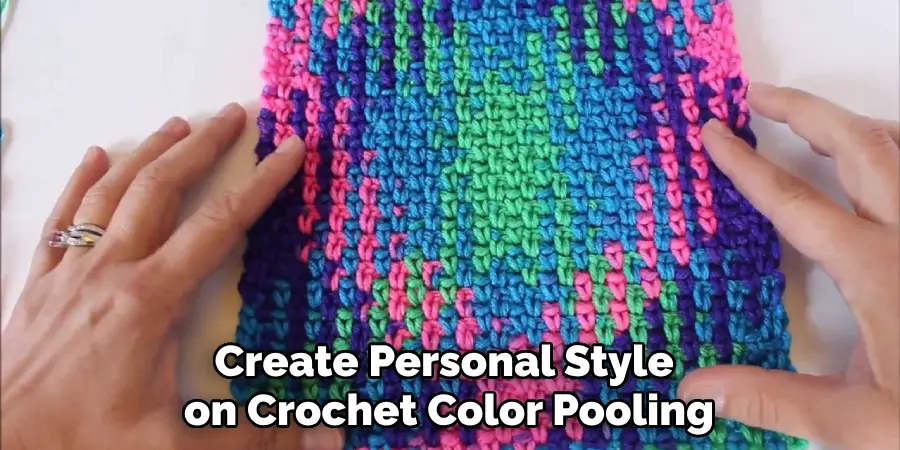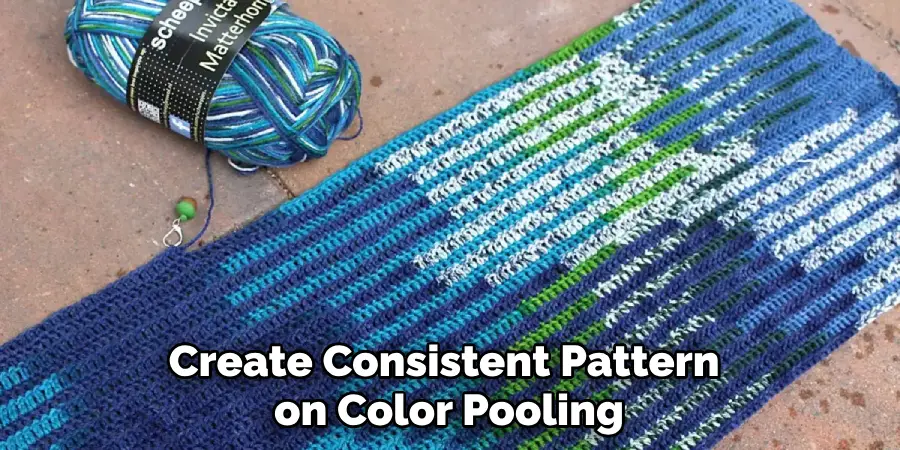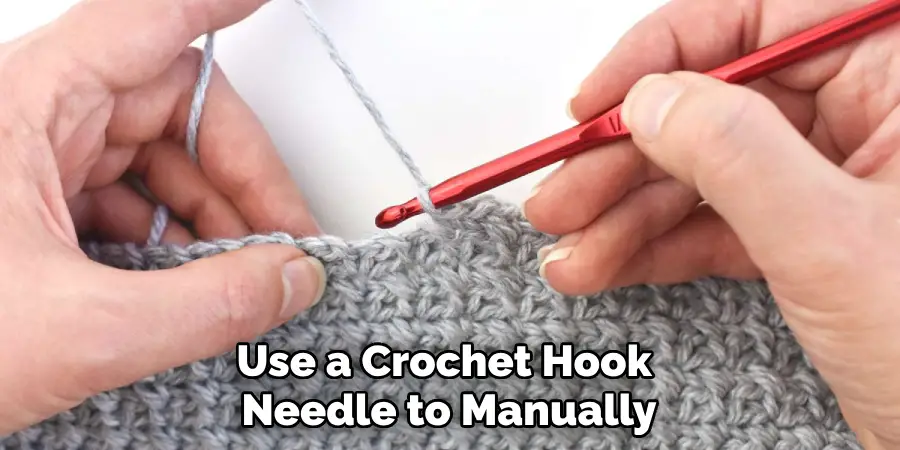Do you want to apply colorful patterns to your crochet projects? Have you ever heard of color pooling and wondered just what it is? Color pooling in crocheting is a technique that allows for multi-colored designs using the basic stitches, with a single skein of yarn. This method results in beautiful, eye-catching patterns that resemble waves or marbling.

Whether you are an experienced crocheter looking to add an exciting new element to your work, or someone completely new striving to learn the basics, this guide on how to crochet color pooling will help you get acquainted with color pooling and explain how exactly it works.
Why May You Want to Crochet Color Pooling?
1 . To Create Unique, Eye-catching Patterns
Crochet color pooling is a technique that allows you to create mesmerizing and intricate patterns using only basic crochet stitches. By manipulating the colors of your yarn, you can create stunning designs that will surely catch everyone’s attention.
2 . To Challenge Yourself as a Crocheter
If you are an experienced crocheter looking for a new challenge, then crochet color pooling is definitely worth a try. This technique requires precision and careful planning, making it a fantastic way to hone your skills and take your crocheting to the next level.
3 . To Use Up Your Yarn Stash
Do you have leftover yarns that are too small for bigger projects but too much to throw away? Crochet color pooling is the perfect solution for using up those yarn scraps. With this technique, you can create beautiful projects even with small bits of leftover yarn.
4 . To Add a Personal Touch to Your Projects
Crocheting is not just about following patterns – it’s also about expressing your creativity and personal style. By learning how to crochet color pooling, you can add your own unique touch to any project and make it truly one-of-a-kind.

5 . To Join the Crochet Color Pooling Community
Crochet color pooling has gained popularity in recent years, with many crocheters sharing their stunning creations on social media. By learning this technique, you can join a growing community of passionate crocheters and get inspired by their beautiful and creative projects.
So, whether you want to challenge yourself as a crocheter or add a personal touch to your projects, learning how to crochet color pooling is definitely worth your time and effort. So why not give it a try and see the amazing results for yourself?
How to Crochet Color Pooling in 5 Easy Steps
Step 1: Understanding Color Pooling
Color pooling is the art of using variegated yarn to create a specific pattern or design in your crochet project. It involves strategically placing stitches in a way that creates a consistent color pattern, even though the yarn itself may have multiple colors.
Step 2: Choosing the Right Yarn
The key to successful color pooling is choosing the right yarn. Look for variegated yarns with long color repeats, meaning the colors change gradually over a longer distance. This will make it easier to create and maintain a consistent pattern.
Step 3: Finding the Right Stitch
The most commonly used stitch for color pooling is the single crochet (SC). However, you can also use other stitches such as half double crochet (HDC) or double crochet (DC). Experiment with different stitches to find the one that works best for your project.
Step 4: Gauge is Key
Once you have chosen your yarn and stitch, it’s important to check your gauge before starting your project. This will ensure that your color pooling pattern turns out as desired. You can adjust your hook size if needed to achieve the correct gauge.

Step 5: Start Color Pooling
To start color pooling, begin your project as you normally would with the chosen stitch. As you work, pay attention to the colors in your yarn and how they align with your stitches. If needed, adjust the number of stitches in each row to maintain the desired pattern.
Tips for Success
1 . Choose the Right Yarn
When it comes to color pooling, choosing the right yarn is essential. You want to select a variegated or self-striping yarn in order to achieve the desired effect. Look for yarn that has long color repeats and a consistent dye pattern.
2 . Understand Color Pooling
To successfully crochet with color pooling, you need to understand how colors interact with each other. The key is to match the color repeats of the yarn with the number of stitches in your project. This will create a consistent and planned pooling effect.
3 . Use a Solid Base
In order for the colors to pool correctly, you need to use a solid base yarn in a complementary or contrasting color. This will provide contrast and allow the variegated yarn to stand out.
4 . Practice Makes Perfect
Color pooling can take some practice to get right. Don’t be discouraged if your first few attempts don’t turn out as planned. Keep practicing and experimenting with different yarns and stitches until you find what works for you.
5 . Experiment with Stitch Patterns
Different crochet stitch patterns can produce different color-pooling effects. Don’t be afraid to try out different stitch patterns and see how they interact with your variegated yarn. You may discover a new and unique effect.

6 . Tension is Key
Maintaining consistent tension throughout your project is crucial for achieving a successful color-pooling effect. If your tension varies, it can disrupt the planned pooling and result in a less desirable outcome.
7 . Have Fun and Get Creative
Color pooling is all about having fun and experimenting with color. Don’t be afraid to get creative and try new things. You may come up with your own unique color-pooling method or pattern that others will want to replicate. The possibilities are endless when it comes to crochet color pooling. So have fun and enjoy the process!
Frequently Asked Questions
What Precautions Should I Take Before Attempting Color Pooling Technique?
Before you get started on the color pooling technique, it’s important to have a good understanding of basic crochet stitches and techniques. Additionally, it’s recommended to practice with smaller projects first before attempting larger ones. This will help you get a feel for tension and gauge, which are crucial in achieving successful color pooling.

What Yarn Should I Use for Color Pooling?
The best yarns to use for color pooling are those that have long color repeats or gradual color changes. This allows the colors to line up more easily and create a consistent pattern.
Variegated yarns with short color repeats may not work well for this technique. Also, choose a yarn with a smooth and even texture to help prevent any inconsistencies in your stitches.
How Do I Determine the Starting Chain for Color Pooling?
To determine the starting chain for color pooling, you will need to create a swatch using your chosen yarn and hook. Start by chaining a multiple of the desired pattern repeat (e.g. if the pattern is 3 stitches, chain in multiples of 3). Then, work a few rows in the chosen stitch pattern.
Measure the width of your swatch and note how many pattern repeats fit within that measurement. This will be your starting chain for color pooling.
What Stitch Patterns Work Best for Color Pooling?
The most commonly used stitch patterns for color pooling are moss/linen stitch, single crochet, and half double crochet. These stitches create a tight fabric with minimal gaps between stitches, making it easier for the colors to line up. However, feel free to experiment with different stitch patterns to see what works best for your yarn and hook size.
Are There Any Tips for Tension When Color Pooling?
Tension is crucial in color pooling as it determines the size and consistency of your stitches, which in turn affects the color pattern. When working with variegated yarns, it’s important to maintain consistent tension throughout your project to ensure the colors line up correctly.
If you find that your tension varies too much, try using a different hook size or practicing on smaller projects until you feel more comfortable.
How Do I Fix Mistakes in Color Pooling?
Mistakes can happen when color pooling, especially when working with variegated yarns. One way to fix mistakes is to simply unravel the stitch or row and redo it. Another option is to use a crochet hook or tapestry needle to manually adjust the colors back into place.

It’s important to not get discouraged by mistakes and to keep practicing until you feel more confident with the technique. Remember, practice makes perfect!
Can I Use the Color Pooling Technique with Any Yarn or Hook?
Yes, you can use the color pooling technique with any yarn and hook. Keep in mind that the results may vary depending on the yarn weight, fiber content, and hook size used. It’s recommended to experiment with different combinations to see what works best for your desired outcome.
And remember, have fun and don’t be afraid to try new things! So go ahead and grab your favorite yarn and hook, and give color pooling a try. Who knows, you may just discover a new favorite crochet technique.
Can I Adjust the Size of My Color Pooling Project?
Yes, you can adjust the size of your color pooling project by simply changing the starting chain or adding more rows to your project. Keep in mind that this may affect the overall look and placement of the colors in your pattern.
It’s recommended to make a small swatch first to see how changes in stitch count will affect the color pooling before making adjustments to your project. With a little bit of trial and error, you can create beautiful color-pooled projects in any size you desire.
Conclusion
Crochet color pooling is a fun and unique technique that allows you to create visually stunning projects using variegated yarn. By following these tips for success, you can master the art of color pooling and create beautiful, one-of-a-kind pieces.
Now you know how to crochet color pooling! Remember to choose the right yarn, understand color pooling, use a solid base, practice, experiment with stitch patterns, maintain consistent tension, and most importantly – have fun! Happy crocheting!


